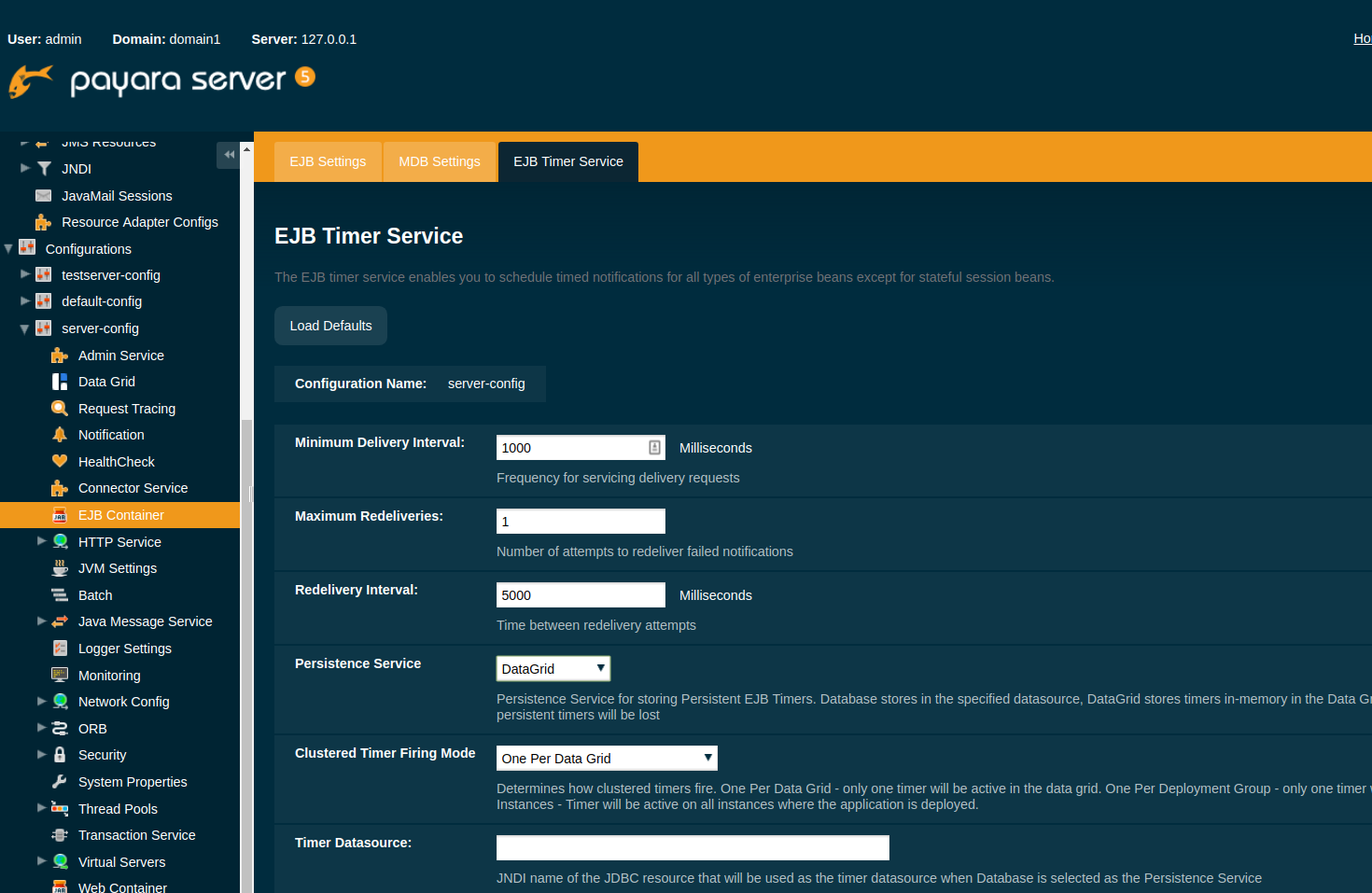This page list the improvements done to EJB configuration and deployment on Payara Server.
Controlling Stateless EJB Concurrent Instances
Since Payara Server 4.1.2.172
In prior releases, it was not possible to control the maximum number of concurrent Stateless EJB instances in Payara Server. It was, however, possible to control the number of pooled Stateless EJB instances, as well as concurrent MDB instances.
| These features were available in Oracle GlassFish Server 3.1 and earlier but not in the GlassFish Open Source editions (3.1.2.x and 4.x). |
It is now possible to limit concurrent Stateless EJB instances that are dispatched, allowing fine-grained control of resources, limiting surface area for DDOS attacks and making applications run more smoothly and efficiently.
The key difference is that previously it was not possible to limit the number of concurrent threads dispatched for the same Stateless EJB, the only limit was the number of pooled beans. When the pool ran out, new EJB instances were created, with no upper bound. In the current release, this upper bound can be established so the maximum number of threads is not exceeded beyond this value.
These limits are controlled on a per-EJB basis, using bean-pool elements in the
glassfish-ejb-jar.xml deployment descriptor file:
| Element | Behaviour |
|---|---|
|
This element controls the maximum concurrent instances that are dispatched for this EJB (number of threads). The default is configured in the domain; this has not changed from previous versions. |
|
This element controls what to do when the number of requests exceeds the amount of beans available in the pool. Possible values of this element include:
|
|
This element controls the minimum number of beans in the bean pool. This will increase performance at the expense of memory footprint. |
Additionally, a new system property fish.payara.ejb-container.max-wait-time-in-millis
can be set to change the default global value of <max-wait-time-in-millis>
for all Stateless EJB bean pools.
| Unless overridden in the deployment descriptor file, this will become the new default value and can be used to cap the upper bound of all concurrent invocations of any Stateless EJB pools. |
Example
The following is a sample glassfish-ejb-jar.xml deployment descriptor that configures
2 EJBs with the settings mentioned beforehand.
<?xml version="1.0" encoding="UTF-8"?>
<!DOCTYPE glassfish-ejb-jar PUBLIC "-//GlassFish.org//DTD GlassFish Application Server 3.1 EJB 3.1//EN" "http://glassfish.org/dtds/glassfish-ejb-jar_3_1-1.dtd">
<glassfish-ejb-jar>
<enterprise-beans>
<ejb>
<ejb-name>PooledStatelessBean</ejb-name>
<bean-pool>
<max-pool-size>1</max-pool-size>
<max-wait-time-in-millis>0</max-wait-time-in-millis>
<steady-pool-size>1</steady-pool-size>
</bean-pool>
</ejb>
<ejb>
<ejb-name>PooledMDB</ejb-name>
<bean-pool>
<max-pool-size>1</max-pool-size>
<resize-quantity>1</resize-quantity>
</bean-pool>
</ejb>
</enterprise-beans>
</glassfish-ejb-jar>Overwriting the Module Name
Since Payara Server 4.1.2.174
When deploying an EJB-JAR module on Payara Server, the portable JNDI names for all scanned EJBs will be generated using the name of the module as specified on the ejb-jar.xml deployment descriptor:
<?xml version="1.0" encoding="UTF-8"?>
<ejb-jar xmlns = "http://java.sun.com/xml/ns/javaee"
version = "3.1"
xmlns:xsi = "http://www.w3.org/2001/XMLSchema-instance"
xsi:schemaLocation = "http://java.sun.com/xml/ns/javaee http://java.sun.com/xml/ns/javaee/ejb-jar_3_1.xsd">
<module-name>MODULE_NAME</module-name>
</ejb-jar>| If the name’s not specified in the deployment descriptor, the specification states that the module name will be the same as the JAR artifact used to deploy it. |
However, When deploying a JAR from an IDE (like NetBeans or IntelliJ), the IDE
deploys to Payara Server using the asadmin deploy command, with the --name option
specified. This will force the module to have the specified name over the name
defined in ejb-jar.xml. This is undesired because the IDE usually infers the
module name from the name of the project or the JAR file and doesn’t take the correct name
of the module into account.
In the current release, an improvement has been implemented to solve this scenario:
The module name defined in the deployment descriptor will always be used even if it
tries to be overridden using the -name option.
In the case you need to overwrite the name of the module when deploying
the module, use the --forceName command option.
|
Persistent EJB Timers with the Domain Data Grid
Since Payara Server 5.181
It is possible to persist an EJB Timer to the Domain Data Grid rather than to a database. The same feature is standard in Payara Micro.
Persisting an EJB Timer to the Domain Data Grid means that the Data Grid itself will store the timer details, preserving it even if the original instance leaves the cluster.
| All stored timers are lost if the whole domain is stopped. |
| This feature is tech-preview and is subject to change. Use with caution. |
The Persistence service for EJB Timers can be set in the administration console by navigating to the EJB Timer Service tab in the EJB Container node of a configuration. To use the Data Grid to store EJB Timers set the Persistence Service to Data grained

EJB Timers will be coordinated across a single deployment group and if an instance of the deployment group is stopped another instance in the same deployment group will take ownership of the timer and ensure it is fired.
| Clustered Timer Firing Mode is NOT user in this version of Payara Server and is always "One Per Deployment Group" |
It is also possible to set the
ejb-timer-service from asadmin. To get the current state, run the following
command:
asadmin> get configs.config.${your-config}.ejb-container.ejb-timer-serviceThis will return the current state from the domain.xml, which by default should be something similar to the following:
asadmin> get configs.config.server-config.ejb-container.ejb-timer-service
configs.config.server-config.ejb-container.ejb-timer-service.ejb-timer-service=Database
configs.config.server-config.ejb-container.ejb-timer-service.max-redeliveries=1
configs.config.server-config.ejb-container.ejb-timer-service.minimum-delivery-interval-in-millis=1000
configs.config.server-config.ejb-container.ejb-timer-service.redelivery-interval-internal-in-millis=5000
Command get executed successfully.To persist to the DataGrid you need only change the value for configs.config.server-config.ejb-container.ejb-timer-service.ejb-timer-service
to DataGrid. To do this, run the following set command:
asadmin> set configs.config.server-config.ejb-container.ejb-timer-service.ejb-timer-service=DataGridset commands are not dynamic. You will need to restart your domain to apply
the changes.
Timer Migration
EJB Timers stored in the Domain Data Grid support timer migration between Instances in the same Deployment Group. You can migrate timers using the Administration console from the Deployment Group page. Timers can also be migrated between instances using asadmin.
asadmin> migrate-timers --target server1 server2
where server1 is the active instance to migrate timers to and server2 is the failed instance.
